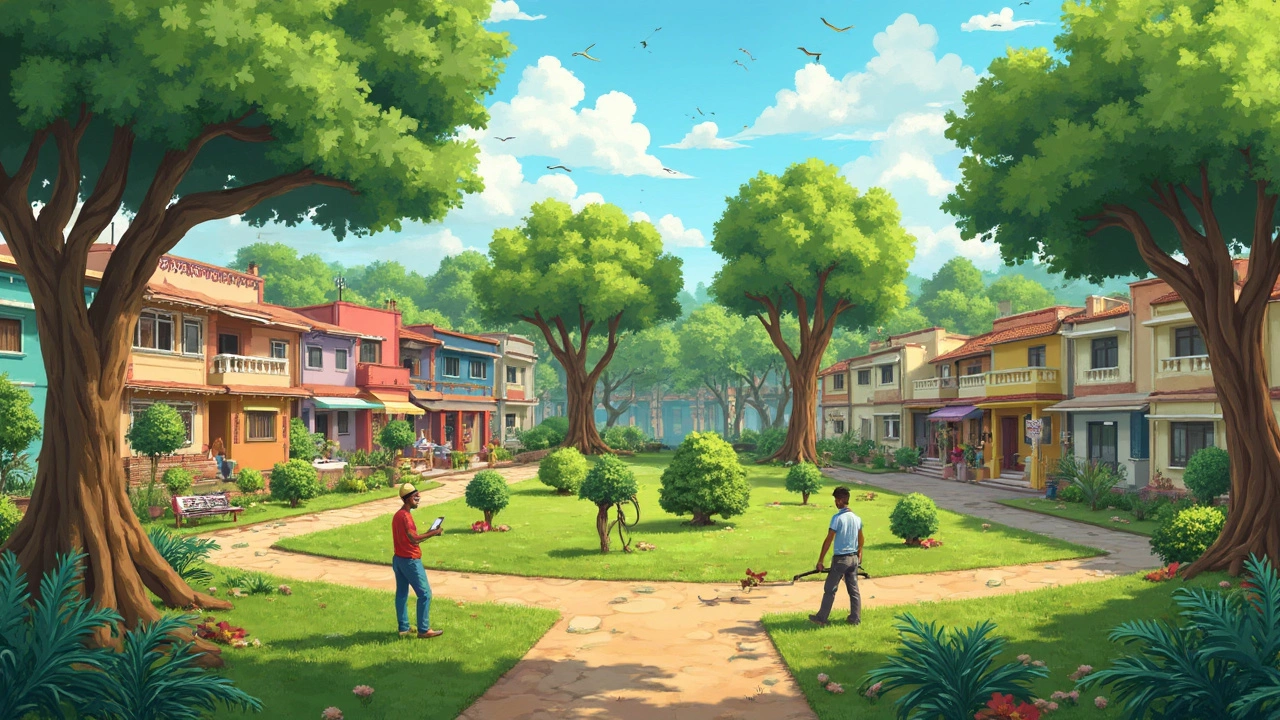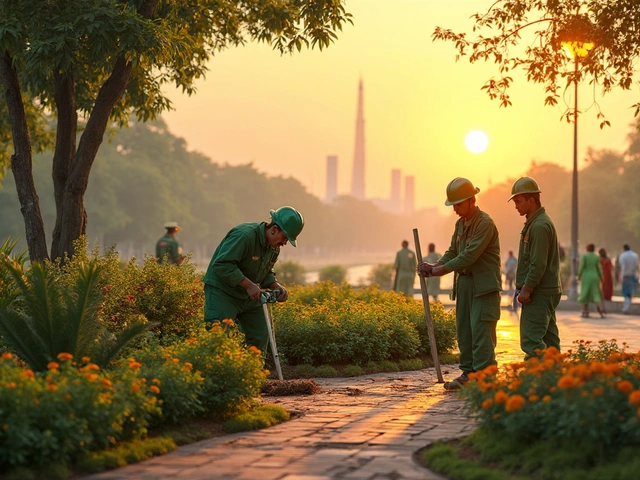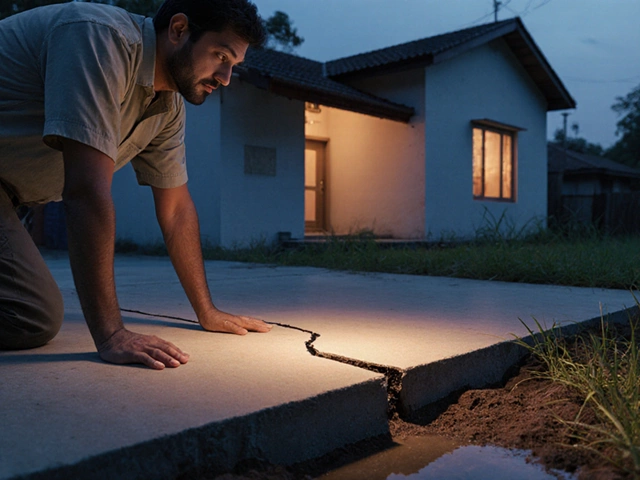Ever watched a neighbor’s yard go from wild jungle to magazine-worthy perfect and wondered how it happens? It isn’t magic. It’s a landscaper, working behind the scenes, sweat on their brow, reshaping a plot of earth into something special. Most folks just think it’s grass-cutting or planting a few bushes, but that’s only scratching the surface. Anyone who’s paid attention to the booming home improvement trends knows the best outdoor spaces usually come from a pro’s touch. But what exactly is that landscaper doing, day in and day out?
If you’re picturing a guy with a mower rolling through some grass, you’re only halfway there. Landscaping is a whole ecosystem of tasks, blending art, science, and some seriously tough labor. From design blueprints to soil testing, they balance ecology and creativity to bring out the best in a space. And as people spend more time at home—especially after the backyard renaissance that started in 2020—good landscapers have become low-key legends in a neighborhood.
The Many Hats a Landscaper Wears
Forget the old movie image of a landscaper as just a guy with a shovel. The job is a patchwork of unique skills and daily shifts in focus. One day, a landscaper could be ankle-deep in mud, hauling rocks to build a retaining wall. The next, they’re squinting at a landscape design plan, picking the perfect native flowers that will actually survive three months of August sun. Landscapers work in every sort of weather, digging holes in icy spring mornings, battling mid-summer heat, and even prepping yards for winter like horticultural superheroes.
Design is an unexpected part of the job. Many landscapers start with sketches or 3D software to lay out garden beds, walkways, and outdoor rooms. They factor in drainage, sunlight, the needs of local pollinators, and of course, the client’s wish-list—sometimes even mixing stone with wood or water features for a zen effect. It’s part science, part creativity. Lighting, water systems, retaining walls—these don’t magically fall from the sky. Landscapers measure, plan, source materials, and handle the tricky stuff, like setting up irrigation so that turf actually stays green (and the water bill doesn’t make you faint).
Some days are more physical than others. Think hauling 50-pound bags of mulch, swinging a power trimmer, and replanting entire sections of a lawn by hand. There’s earth moving, stone-laying, dense root systems to cut through, and a million things that can go sideways if you’re not paying attention to safety (slippery slopes, power tool mishaps—it’s not always gentle work). The American Bureau of Labor Statistics reported that over 1 million people in the U.S. work as landscaping and groundskeeping workers, with injuries most likely during hotter months or heavy construction projects.
But there’s more: pest control, weed management, fertilizer calculations, tree pruning, and emergency rescue when a plant is about to croak. A sharp-eyed landscaper can spot fungus before it wipes out your roses or recommend drought-resistant replacements if your irrigation system isn’t up to scratch. Some even get certified as arborists or specialize in eco-friendly landscaping, using rain gardens and native species to keep yards green and wildlife-friendly.
That’s not even counting the time spent chasing after supplies or hauling green waste. If you’ve ever seen a pickup stacked high with clippings and wondered where it all goes, here’s the scoop—landscapers haul it off to composting centers or mulch stations. And certain towns require special dumping permits or charge by the cubic yard, so a pro has to budget for paperwork just as much as petunias.
Wondering how they keep it all straight? Many landscapers swear by checklists and color-coded project calendars, especially during the spring-summer rush. It’s not uncommon for a busy crew to tackle 3–5 separate properties in a single day with a plan tight enough to make an airline pilot jealous.

What Services Do Landscapers Offer? It’s More Than You Think
Landscaping has come a long way from the days when you just hired someone to “cut the grass.” In 2024, you can get a menu of options from a good landscaping company. Check out some of the core services:
- Landscape Design: This is where the magic starts. A pro gets to know a client’s taste, checks out the site, sketches ideas, and selects materials. Computer programs now let landscapers show 3D renderings so you can preview your new garden before anyone touches a shovel.
- Lawn & Turf Care: Regular mowing, edging, seeding, aeration, and precise fertilization schedules—did you know there’s actually a wrong way to mow, and it can ruin your grass?
- Planting & Softscaping: Choosing shrubs, trees, perennials, annual flowers, and getting them in the ground the right way so they survive (new trees need a two-year head start before they’re really established).
- Hardscaping: Think patios, walkways, fire pits, stone walls, driveways, and anything built from stone, pavers, or wood. This takes brawn and brains—an uneven patio will make a grill tip over, and nobody wants that.
- Irrigation Systems: Drip lines, pop-up sprinklers, rain sensors, timers. The difference between a crispy brown lawn and a lush green retreat? Usually, a landscaper’s know-how on water management.
- Pest & Weed Control: Applying the right herbicides, removing invaders by hand, or installing specialized fabrics under mulch to block weeds—all while keeping pets and pollinators safe.
- Seasonal Cleanups: Fall leaf removal, prepping for winter (including wrapping valuable shrubs), spring dethatching, and garden bed refreshes. Landscapers know when to prune without shocking a plant to death.
- Lighting: This isn’t just plugging in a few solar lights. It’s wiring pathways, spotlights, and creating drama by lighting up trees or water features safely.
- Drainage Solutions: Swamps or puddles in your yard after every storm? Pros know how to fix grading, install French drains, or add river rock beds to move water away from your house.
You want data? Residential landscaping revenue in the U.S. alone topped $128 billion in 2023, according to IBISWorld. Homeowners are spending not just on the basics, but on upgrades: fire pits, swimming pool landscaping, edible gardens, and even backyard putting greens.
Here’s a quick snapshot of the most requested professional landscaping services last year:
| Service | Percentage of Requests |
|---|---|
| Lawn Maintenance | 32% |
| Landscape Design/Installation | 24% |
| Hardscaping | 17% |
| Pest & Weed Control | 12% |
| Tree & Shrub Care | 9% |
| Irrigation System Services | 6% |
The modern landscaper has to be a Swiss army knife of skills—or know how to hire the right subcontractors. Many now offer eco-friendly services, using rain barrels for irrigation, planting pollinator-friendly beds, or building with recycled materials. If your landscaper is certified with groups like the National Association of Landscape Professionals or state horticultural boards, that’s usually a green flag.
Here’s a tip: want to save money on water and still have green grass? Ask your landscaper about “smart” irrigation controllers. These babies adjust watering schedules based on real-time weather data so you don’t end up watering during a rainstorm. They’re now required in many drought-prone areas, and yet most homeowners have never even heard of them.
And don’t be shy about asking your landscaper for low-maintenance options. They can suggest slow-growing grass species, install landscape fabric, or swap in stone mulch beds to keep weeds and trimming down. This makes a huge difference if you work long hours or travel a lot.
If you need something special like a healing garden, a butterfly habitat for kids, or an outdoor kitchen area, bring those ideas up early. The best landscapers love a challenge and have done wilder projects than you might think—one crew I know turned a skinny city lot into an Italian-style courtyard, complete with grapevines and tabletop fountains. It takes experience to make those visions come true without blowing up your budget.

Tangible Benefits of Hiring a Pro—and What to Watch Out For
Think hiring a landscaper is just a luxury? Consider this: according to a study by the National Association of Realtors, homeowners can recoup up to 267% of the cost of landscaping when selling. That’s more than a kitchen remodel in some markets. Good landscaping adds curb appeal, reduces energy costs (shade trees lower summer A/C bills), and even improves mental health. More schools, hospitals, and apartment buildings are hiring professional landscapers to create calming green areas that lower stress and boost productivity for everyone inside.
Professionals also have better gear. Commercial mowers, trenchers, and aerators do in a single morning what would take you all weekend by hand. And their work is safer. Landscapers train for chemical handling, power tool safety, and ergonomic lifting—important in a job the CDC ranks in its top ten for back injuries.
By the way, most reliable landscapers have insurance and proper licensing. Don’t skip checking those! An uninsured crew might save a few bucks on your quote, but if your neighbor’s fence gets wrecked or someone gets hurt, you could be on the hook.
Ask for references. Professional landscapers will gladly show off before-and-after photos, or walk you through a finished project in your area. Got doubts about their plant know-how? Ask which local species can handle a late frost or months of drought. If the crew shrugs or fumbles for an answer, they might not be the real deal.
What about price? Rates vary wildly by region, but for a full-service maintenance contract, expect anywhere from $50 for a quick mow up to $500+ a month for big yards with lots of extras. Design and full installations (like patios or lighting) can run from a couple of thousand dollars into six figures, depending how wild you want to get. Here’s what usually impacts price the most:
- Yard size
- Type and scope of work
- Materials selected (stone vs. concrete, annuals vs. mature trees)
- Local labor rates
- Ongoing maintenance vs. a one-time project
If budget is tight, ask for phases—a good landscaper will help break projects into chunks. Start with soil improvement and hardscaping, then add plantings and lighting as you go. This keeps your yard functional, lets you spread out costs, and still reaps the return on investment.
Bonus tip—do your homework about seasonal timing in your region. Landscapers book up fast spring through early summer and late fall, so get on their schedule early for the best rates and slots.
Curious about DIY? There’s no shame in tackling your own yard, but pros bring design sense and problem-solving that dodges rookie mistakes, like tilting patios, neighbor disputes about fence lines, or planting water-hogging trees where they’ll mess up your pipes.
One thing is clear: a professional landscaper does way more than mow lawns. They create spaces you’ll want to show off, whether that means lush privacy screens, party-perfect patios, edible gardens, or wildflower beds buzzing with bees and butterflies. Behind every neat hedge or blooming planter, there’s usually a dedicated pro who’s spent years mastering the tricks of the trade—and your yard is their canvas.






